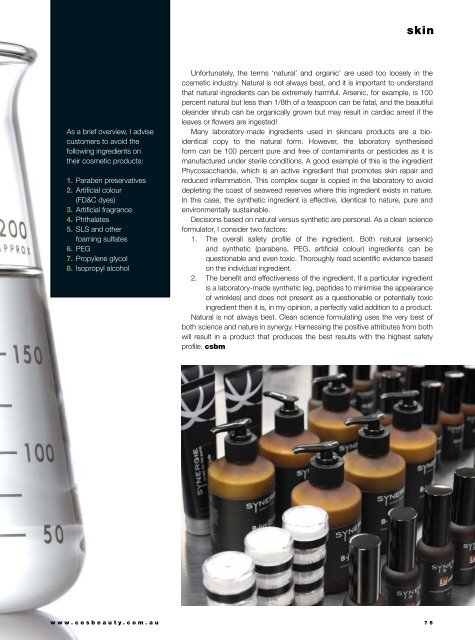Cosmetic Surgery and Beauty Magazine #68
You also want an ePaper? Increase the reach of your titles
YUMPU automatically turns print PDFs into web optimized ePapers that Google loves.
skin<br />
As a brief overview, I advise<br />
customers to avoid the<br />
following ingredients on<br />
their cosmetic products:<br />
1. Paraben preservatives<br />
2. Artificial colour<br />
(FD&C dyes)<br />
3. Artificial fragrance<br />
4. Phthalates<br />
5. SLS <strong>and</strong> other<br />
foaming sulfates<br />
6. PEG<br />
7. Propylene glycol<br />
8. Isopropyl alcohol<br />
Unfortunately, the terms ‘natural’ <strong>and</strong> organic’ are used too loosely in the<br />
cosmetic industry. Natural is not always best, <strong>and</strong> it is important to underst<strong>and</strong><br />
that natural ingredients can be extremely harmful. Arsenic, for example, is 100<br />
percent natural but less than 1/8th of a teaspoon can be fatal, <strong>and</strong> the beautiful<br />
ole<strong>and</strong>er shrub can be organically grown but may result in cardiac arrest if the<br />
leaves or flowers are ingested!<br />
Many laboratory-made ingredients used in skincare products are a bioidentical<br />
copy to the natural form. However, the laboratory synthesised<br />
form can be 100 percent pure <strong>and</strong> free of contaminants or pesticides as it is<br />
manufactured under sterile conditions. A good example of this is the ingredient<br />
Phycosaccharide, which is an active ingredient that promotes skin repair <strong>and</strong><br />
reduced inflammation. This complex sugar is copied in the laboratory to avoid<br />
depleting the coast of seaweed reserves where this ingredient exists in nature.<br />
In this case, the synthetic ingredient is effective, identical to nature, pure <strong>and</strong><br />
environmentally sustainable.<br />
Decisions based on natural versus synthetic are personal. As a clean science<br />
formulator, I consider two factors:<br />
1. The overall safety profile of the ingredient. Both natural (arsenic)<br />
<strong>and</strong> synthetic (parabens, PEG, artificial colour) ingredients can be<br />
questionable <strong>and</strong> even toxic. Thoroughly read scientific evidence based<br />
on the individual ingredient.<br />
2. The benefit <strong>and</strong> effectiveness of the ingredient. If a particular ingredient<br />
is a laboratory-made synthetic (eg, peptides to minimise the appearance<br />
of wrinkles) <strong>and</strong> does not present as a questionable or potentially toxic<br />
ingredient then it is, in my opinion, a perfectly valid addition to a product.<br />
Natural is not always best. Clean science formulating uses the very best of<br />
both science <strong>and</strong> nature in synergy. Harnessing the positive attributes from both<br />
will result in a product that produces the best results with the highest safety<br />
profile. csbm<br />
www.cosbeauty.com.au 75


















